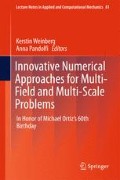Abstract
This work presents a parametric design approach to simply-supported structures, exhibiting minimal mass tensegrity architectures (axially-loaded prestressible configurations of axially-loaded members) in two-dimensions. This provides minimal mass bridge structures in the plane. The mass minimization problem considers a distributed loading condition, under buckling and yielding constraints. The minimal mass structure is proved to be a tensegrity system with an optimal complexity. This optimal complexity (number of structural elements) depends only on material properties and the magnitude of the external load. The fact that the minimal mass structure is a Class 1 Tensegrity substructure has significant economic advantage. Class 1 structures are less expensive to construct, and substructures are easily deployable, offering portable applications for small spans. They can be easily assembled for prefabricated component parts for large spans. This minimal mass theory is then used to design a support structure for a solar panel cover of water canals, stopping evaporative losses and generating power without requiring additional land.
Access this chapter
Tax calculation will be finalised at checkout
Purchases are for personal use only
References
Skelton, R. E., & Nagase, K. (2012). Tensile tensegrity structures. International Journal of Space Structures, 27, 131–137.
Skelton, R. E., & de Oliveira, M. C. (2010). Optimal complexity of deployable compressive structures. Journal of the Franklin, I(347), 228–256.
Skelton, R. E., & de Oliveira, M. C. (2010). Optimal tensegrity structures in bending: the discrete Michell truss. Journal of the Franklin, I(347), 257–283.
Nagase, K., & Skelton, R. E. (2014). Minimal mass tensegrity structures. Journal of the International Association for Shell and Spatial Structures, 55(1), 37–48.
Skelton, R. E., & de Oliveira, M. C. (2010). Tensegrity systems. New York: Springer.
Carpentieri, G., Skelton, R. E., & Fraternali, F. (2015). On the minimum mass and optimal complexity of planar tensegrity bridges, Internal Report of the University of California, San Diego, Mechanical and Aerospace Engineering, No. 1-2014. www.fernandofraternaliresearch.com/publications/arxiv_tensegrity_bridges_theory_2014.pdf. Accessed 23 June 2015.
Skelton, R. E., Fraternali, F., Carpentieri, G., & Micheletti, A. (2014). Minimum mass design of tensegrity bridges with parametric architecture and multiscale complexity. Mechanics Research Communications, 58, 124–132, ISSN 0093-6413, doi:10.1016/j.mechrescom.2013.10.017.
Koohestani, K. (2012). Form-finding of tensegrity structures via genetic algorithm. International Journal of Solids and Structures, 49, 739–747.
Rhode-Barbarigos, L., Jain, H., Kripakaran, P., & Smith, I. F. C. (2010). Design of tensegrity structures using parametric analysis and stochastic search. Engineering and Computer, 26(2), 193–203.
Sakamoto , T., Ferrè, A., & Kubo, M. (Eds.). (2008). From control to design: Parametric/algorithmic architecture. Actar, Barcelona.
Sokóf, T., & Rozvany, G. I. N.: New analytical benchmarks for topology optimization and their implications. Part I: bi-symmetric trusses with two point loads between supports. Structural and Multidisciplinary Optimization, 46, 477–486 (2012).
Tilbert, A. G., & Pellegrino, S. (2011). Review of form-finding methods for tensegrity structures. International Journal of Space Structures, 18, 209–223.
Yamamoto, M., Gan, B. S., Fujita, K., & Kurokawa, J. (2011). A genetic algorithm based form-finding for tensegrity structure. Procedia Engineering, 14, 2949–2956.
Fraternali, F., Marino, A., El Sayed, T., & Della Cioppa, A. (2011). On the structural shape optimization through variational methods and evolutionary algorithms. Mechanics of Advanced Materials and Structures, 18, 224–243.
Fraternali, F., Farina, I., & Carpentieri, G. (2014). A discrete-to-continuum approach to the curvatures of membrane networks and parametric surfaces. Mechanics Research Communications, 56, 18–25.
Phocas, M. C., Kontovourkis, O., & Matheou, M. (2012). Kinetic hybrid structure development and simulation. International Journal of Architectural Computing, 10(1), 67–86.
Fraternali, F., & Carpentieri, G. (2013). On the correspondence between 2D force networks and polyhedral stress functions. International Journal of Space Structures, 29(3), 145–159.
Michell, A. G. M. (1904). The limits of economy of material in frame-structures. Philosophical Magazine, 8, 589–597.
Kahn, M., & Longcore, T. (2014). A Feasibility Analysis of Installing Solar Photovoltaic Panels Over California Water Canals. UCLA Institute of the Environment and Sustainability, Los Angeles, CA. http://www.environment.ucla.edu/perch/resources/files/adeptfinalreport1.pdf. Accessed 22 July 2014.
Carpentieri, G., Modano, M., Fabbrocino, F., & Fraternali, F. (2015). Optimal design and dynamics of truss bridges. In COMPDYN 2015—5th ECCOMAS Thematic Conference on Computational Methods in Structural Dynamics and Earthquake Engineering (pp. 1731–1740).
Modano, M., Fabbrocino, F., Gesualdo, A., Matrone, G., Farina, I., & Fraternali, F. (2015). On the forced vibration test by vibrodyne. In COMPDYN 2015—5th ECCOMAS Thematic Conference on Computational Methods in Structural Dynamics and Earthquake Engineering (pp. 209–217).
Author information
Authors and Affiliations
Corresponding author
Editor information
Editors and Affiliations
Rights and permissions
Copyright information
© 2016 Springer International Publishing Switzerland
About this chapter
Cite this chapter
Carpentieri, G., Fraternali, F., Skelton, R.E. (2016). A Tensegrity Paradigm for Minimal Mass Design of Roofs and Bridges. In: Weinberg, K., Pandolfi, A. (eds) Innovative Numerical Approaches for Multi-Field and Multi-Scale Problems. Lecture Notes in Applied and Computational Mechanics, vol 81. Springer, Cham. https://doi.org/10.1007/978-3-319-39022-2_5
Download citation
DOI: https://doi.org/10.1007/978-3-319-39022-2_5
Published:
Publisher Name: Springer, Cham
Print ISBN: 978-3-319-39021-5
Online ISBN: 978-3-319-39022-2
eBook Packages: EngineeringEngineering (R0)

